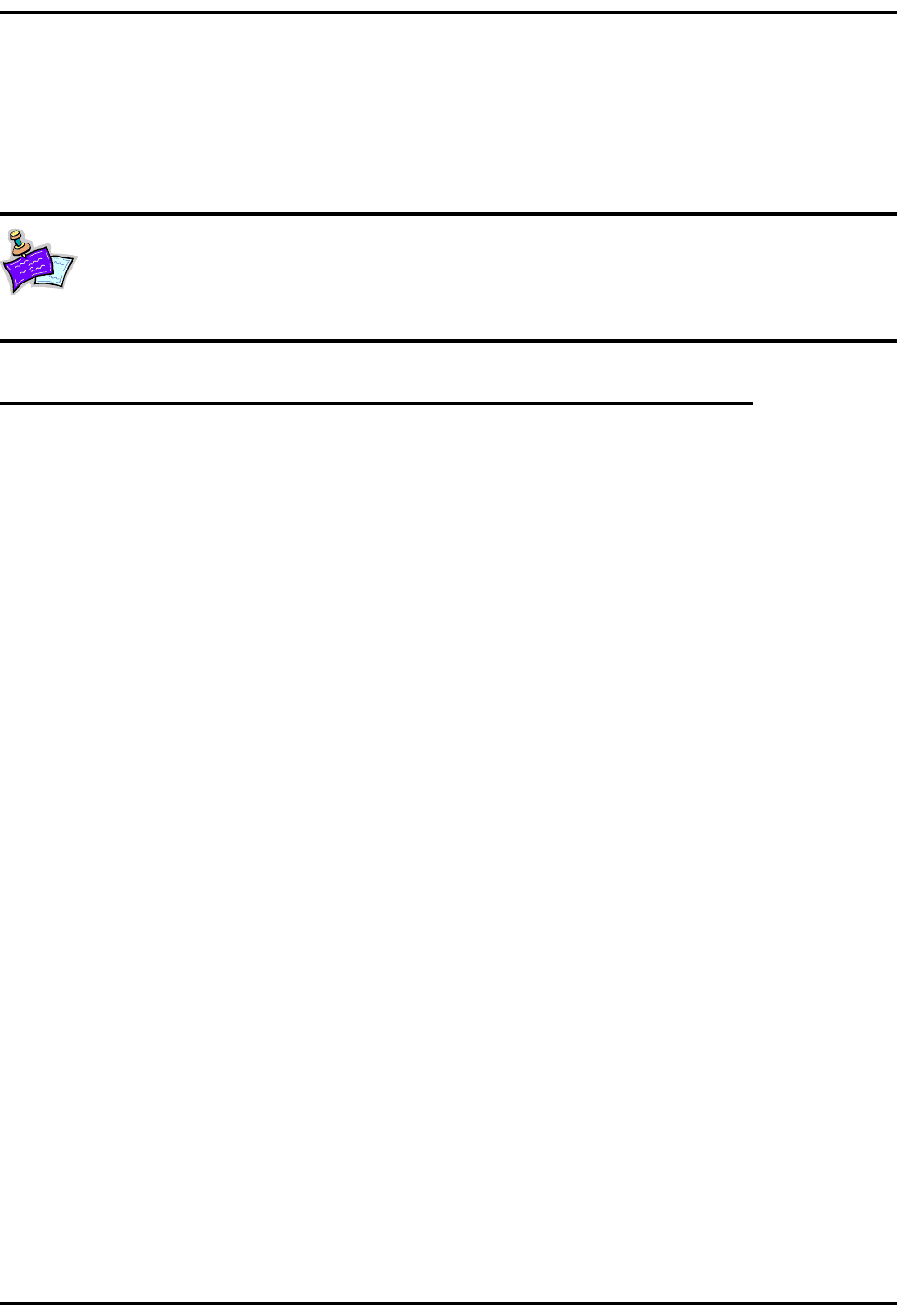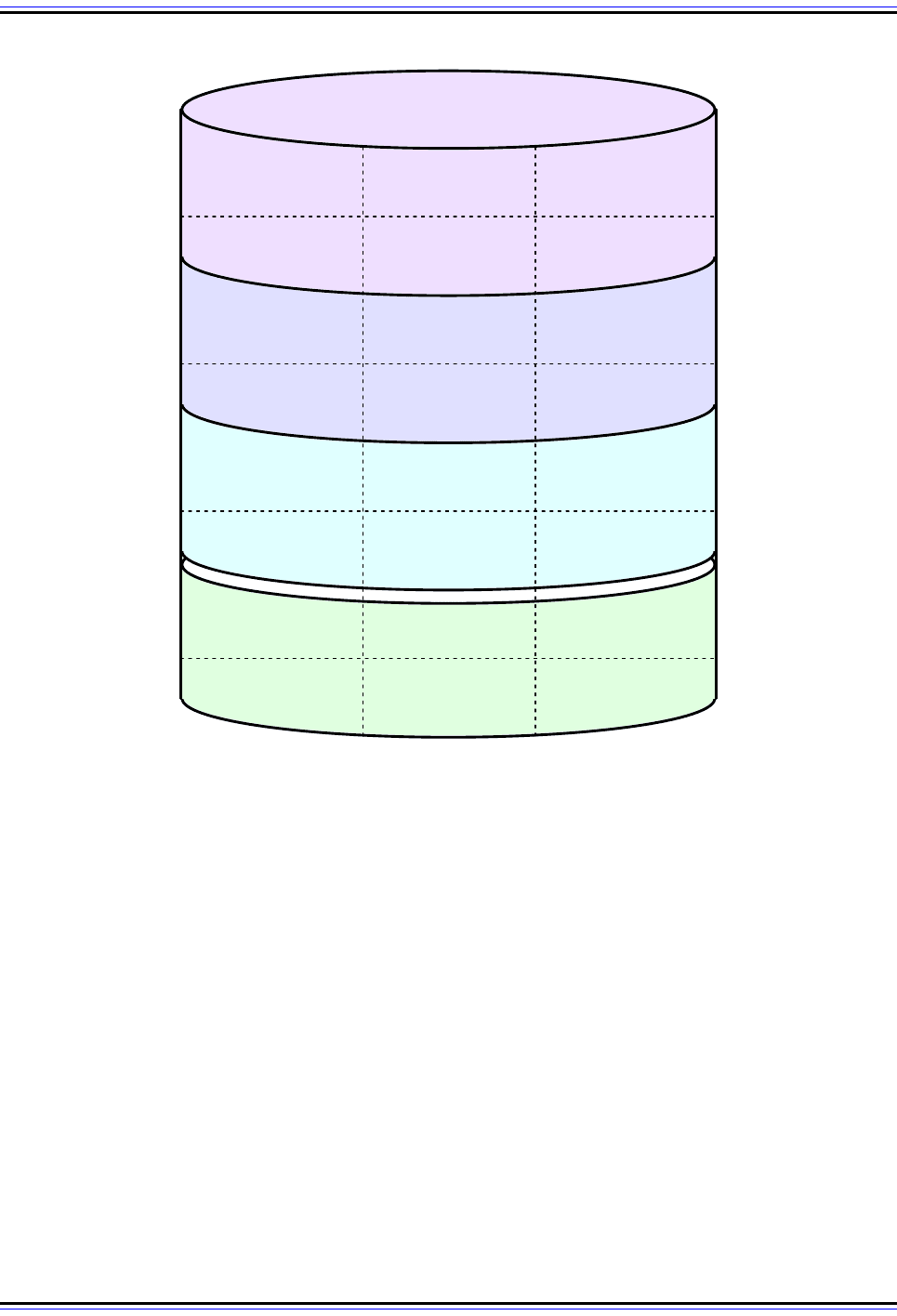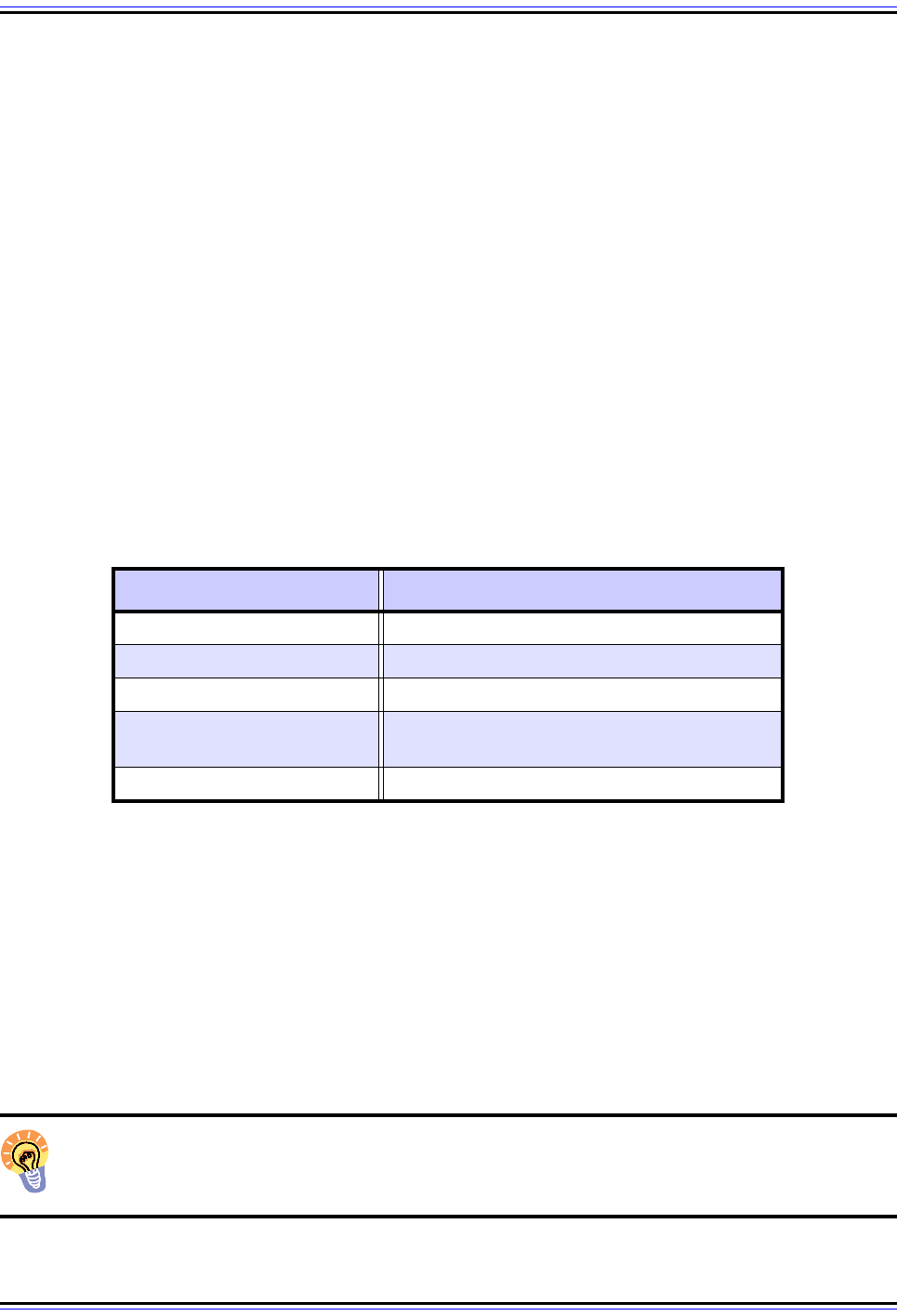Charles M. Kozierok The TCP-IP Guide
Подождите немного. Документ загружается.


The TCP/IP Guide - Version 3.0 (Contents) ` 1221 _ © 2001-2005 Charles M. Kozierok. All Rights Reserved.
On The Web: A full, hyperlinked list of RFCs can be found at: http://www.rfc-
editor.org/rfc-index.html

The TCP/IP Guide - Version 3.0 (Contents) ` 1222 _ © 2001-2005 Charles M. Kozierok. All Rights Reserved.
TCP/IP Structure of Management Information (SMI) and
Management Information Bases (MIBs)
The Internet Standard Management Framework defines three major components that
describe how devices can be managed on a TCP/IP internetwork. One of these, the actual
Simple Network Management Protocol (SNMP) is relatively well-known, but is only part of
the overall picture. SNMP describes how information is exchanged between SNMP entities,
but two other components are equally important because they describe the information
itself.
In this section I describe these two important supporting elements of the TCP/IP Internet
Standard Management Framework: the Management Information Base (MIB) standard that
describes types of information that SNMP works with, and the Structure of Management
Information (SMI) standard that specifies how MIB information is defined. Understanding
these two parts of the SNMP Framework is an important initial step before we examine the
actual SNMP protocol itself.
Since SMI and MIBs are so closely related, they are described in combination here. I begin
with an overview description of the SMI data description language and how management
information bases (MIBs) work. I discuss the MIB object name hierarchy and the notation
used to refer to names. I also describe how MIB objects work, discussing the different
object types and MIB object groups.
Background Information: If you have not yet already read the section describing
the SNMP Internet Standard Management Framework, you should do so before
proceeding here.
Note: I describe here MIB concepts common to all of the versions of SNMP, and
discuss both of the specific versions of SMI (SMIv1 and SMIv2) used in those
SNMP versions.
TCP/IP Structure of Management Information (SMI) and Management
Information Bases (MIBs) Overview
The key to really understanding TCP/IP network management is to comprehend the infor-
mation-oriented nature of the entire Internet Standard Management Framework (SNMP
Framework). To see what I mean by this, let's step back for a moment and consider in
general terms the problem of network management, and more specifically, the problem of
managing devices on a network.

The TCP/IP Guide - Version 3.0 (Contents) ` 1223 _ © 2001-2005 Charles M. Kozierok. All Rights Reserved.
Understanding SNMP's Information-Oriented Design
A network administrator needs to perform two basic types of actions: gather data about
devices to learn how they are functioning, and give commands to devices to change how
they are functioning. In the simplest terms, the first category can be considered like a “read”
operation, and the second is comparable to a “write” operation.
A classical way of implementing this functionality is to define a communication protocol.
Most such protocols are command-oriented—they consist of a specific set of commands to
perform the “read” and “write” operations we mentioned above. For example, a network
management protocol might have a read command such as “report on number of hours
device has been in use”, and a write command such as “put this device into test mode”. The
network manager would control the device by giving the appropriate commands.
A command-oriented management protocol has the advantage of simplicity: it's clear what
the commands are for and how they are to be used. It can be reasonably well-suited for use
in certain environments, but it doesn't work well on a large, heterogeneous TCP/IP inter-
network. The main reason for this is that command-orientation inextricably ties the protocol
to the devices being managed. Consider:
☯ Every type of device might require a distinct set of commands. For example, the
commands given to a router might need to be different than those given to a host. This
would lead either to a proliferation of commands in the protocol, or to inflexibility in
allowing proper management of different device types.
☯ Every time a company created a new type of device, or made a unique version of a
type of device, the network management protocol would have to be changed.
☯ Whenever the operation of a kind of device changed, due perhaps to a change in
another protocol, the management protocol would need to be updated.
☯ The protocol itself could not be easily changed without affecting a lot of hardware.
The solution to the problems of command-oriented management protocols was to use an
information-oriented model. Instead of defining specific commands that interrogate or
control devices, the devices are defined in terms of units of information that are to be
exchanged between the devices and a management station.
Instead of “read” commands and “write” commands, we have variables that can be “read” or
“written”. Take the two examples mentioned earlier. Instead of a command like “report on a
number of hours device has been in use”, the device keeps a variable called “number of
hours in use” and the network management station can “read” this as one of many
variables, with no need for a specific protocol command. Instead of a “write” command
called “put this device into test mode”, the device has a variable called “current mode”. The
network manager can change the mode of the device to “test” by changing the value of the
variable.
This difference may seem subtle, but it in fact underlies every aspect of how SNMP works. I
believe part of why the SNMP Framework is hard to understand is because insufficient
emphasis is placed on looking at things in the “SNMP way”, which means thinking about
information objects and not commands.

The TCP/IP Guide - Version 3.0 (Contents) ` 1224 _ © 2001-2005 Charles M. Kozierok. All Rights Reserved.
Key Concept: Unlike most protocols, which are command-oriented, SNMP is infor-
mation-oriented. SNMP operations are implemented using objects called variables
that are maintained in managed devices. Rather than issuing commands, a network
management station checks the status of a device by reading variables, and controls the
operation of the device by changing (writing) variables.
The Management Information Base (MIB) and MIB Objects
Given this backdrop, we can look at the SNMP Framework in a new light. The actual SNMP
protocol itself, which we'll examine in the next section, has only a few, generic commands to
accomplish “read” and “write” tasks as mentioned just above. It deals with only the methods
by which network management information is exchanged between SNMP agents and
SNMP network management stations. The network management information is really the
heart of TCP/IP network management.
So, instead of SNMP being defined in terms of commands used to control particular
devices, it is defined in terms of management information variables, generally called
objects. Each object describes a particular characteristic of a device. Some objects are
fairly generic and are meaningful for any device on a TCP/IP network; for example, an
object describing something related to the Internet Protocol itself, such as the device's IP
address. Other objects might be particular to a specific type of device; for example, a router
will have objects that a regular host's Ethernet network interface card would not.
A collection of objects used in SNMP is called a management information base, or MIB. (In
fact, SNMP objects are often called MIB objects.) The first version of SNMP, SNMPv1, had
a single standard that defined the entire MIB for SNMP. Newer versions however provide
more flexibility by using different MIB modules that defines sets of variables particular to the
hardware or software used by a device.
Defining objects using modules allows for significant flexibility in defining the variables that
allow management of different types of devices. A device can incorporate all the MIB
modules appropriate to the hardware and software it uses. For example, if you had a device
using Ethernet, it would incorporate variables from the Ethernet MIB; one using Token Ring
would use the Token Ring MIB. Both devices would also use the common SNMP MIB that is
used by all TCP/IP devices. Other modules might also be included as needed. We'll see
more of how this works later in this section.
Key Concept: The management data variables in a managed device are maintained
in a logical collection called a management information base (MIB). The objects in
the MIB are often called MIB objects, and are typically collected into sets called MIB
modules.

The TCP/IP Guide - Version 3.0 (Contents) ` 1225 _ © 2001-2005 Charles M. Kozierok. All Rights Reserved.
Defining MIB Objects: the Structure of Management Information (SMI)
The use of MIB objects solves the problem of the network management protocol being tied
to the network management information. However, we must be very particular about how
we define these objects. Again, the reason is the wide variety of devices that TCP/IP allows
to be connected together. Each device may represent information in a different way; for
them all to communicate with each other, we need to ensure that management information
is represented in a consistent manner.
The part of the SNMP Framework that ensures the universality of MIB objects is the
Structure of Management Information (SMI) standard. SMI defines the rules for how MIB
objects and MIB modules are constructed. In SMI, MIB objects are described using a
precise set of definitions based on a data description language called the ISO Abstract
Syntax Notation 1 (ASN.1) standard.
In essence then, we really have three “levels of abstraction” in SNMP. The actual SNMP
protocol moves values that represent the state of management devices. The MIB defines
what these variables are. And the SMI defines how the variables in the MIB are themselves
defined.
There are two main SMI standards. The original, SMIv1, was part of the first SNMP
Framework, SNMPv1, defined in RFC 1155. It sets out the basic rules for management
information bases and MIB variables. The second, SMIv2, was defined as part of SNMPv2p
in RFC 1442 and further updated in RFC 2578, part of SNMPv3. It is similar to the earlier
version but defines more object types as well as the structure of MIB modules.
These SMI standards are responsible for defining the following important information
elements in SNMP:
☯ The general characteristics associated with all MIB objects. SMI defines the standard
way by which all MIB objects are described.
☯ The different types of MIB objects that can be created, such as integers, strings and
more complex data types.
☯ A hierarchical structure for naming MIB objects, so they can be addressed in a
consistent manner without names overlapping.
☯ The information associated with each MIB module.
Key Concept: The Structure of Management Information (SMI) standard is respon-
sible for defining the rules for how MIB objects are structured, described and
organized. SMI allows dissimilar devices to communicate by ensuring that they use a
universal data representation for all management information.

The TCP/IP Guide - Version 3.0 (Contents) ` 1226 _ © 2001-2005 Charles M. Kozierok. All Rights Reserved.
In fact, the SMI and MIB standards are so closely related that it is hard to discuss one
without the other. The rest of this section discusses SNMP management information struc-
tures making reference to both SNMP Framework components. We'll see how MIB objects
are defined and the characteristics of each, and look at MIB data types, the structure used
to organize MIB objects, and the way MIB modules and object groups work.
Note: Due to its name, the management information base is often called a
“database”. This is, strictly speaking, inaccurate. The MIB is a description of
objects. The actual MIB in a device may be implemented as a software database,
but it need not be.
TCP/IP MIB Objects, Object Characteristics and Object Types
The Internet Standard Management Framework (SNMP Framework) is designed to facil-
itate the exchange of management information. The Management Information Base (MIB)
defines a device's management information. The MIB contains a number of variables called
MIB objects; they are also called managed objects. These objects are defined according to
the rules set out in the Structure of Management Information (SMI) standard.
The best place to begin looking at MIB objects is by examining the SMI rules that define
them. As I mentioned earlier in this section, two different versions of SMI have been
created: SMIv1 as part of the original SNMP, and SMIv2 as part of SNMPv2 and SNMPv3.
The two are similar in terms of how MIB objects are described, but SMIv2 allows more infor-
mation to be associated with each object.
MIB Object Mandatory Characteristics
Just as a typical protocol uses a field format for specifying the content of messages sent
between devices using the protocol, SMI uses a format that specifies the fundamental
characteristics of each MIB object. The most basic of these are five mandatory character-
istics defined in SMIv1. These are also used in SMIv2, but a couple of names were
changed, and the possible values for some of the fields were modified as well. This is
shown conceptually in Figure 272.
Object Name
Each object has a name that serves to uniquely identify it. Actually, that's not entirely true.
Each object actually has two names: a textual name called an Object Descriptor and a
numeric Object Identifier that indicates the object's place in the MIB object name hierarchy.
I'm sure that made no sense to you, but that's why I included the next topic discussing
object naming that hopefully will (make sense that is.)

The TCP/IP Guide - Version 3.0 (Contents) ` 1227 _ © 2001-2005 Charles M. Kozierok. All Rights Reserved.
Syntax
An object’s Syntax defines its data type and the structure that describes it. This attribute of
an MIB object is very important because it defines the data type of information that the
object contains. There are two basic categories of data types allowed:
☯ Regular Data Types: These are single pieces of information, of the type we are used
to dealing with on a regular basis; examples would be integers or strings. These are
called base types in SMIv2. SMIv1 differentiates between primitive types like integers
defined in ASN.1, and defined types that are special forms of primitive types that are
still single pieces of information but with certain special meaning attached to how they
are used. SMIv2 doesn't use those two terms.
Figure 272: SNMP Management Information Base (MIB)
This diagram shows an SNMP management information base containing “N” MIB objects. Each object has
five mandatory characteristics and a variable number of optional characteristics.
Object #1 Name Syntax
Access /
Max-Access
Status
Definition /
Description
Optional
Characteristics
Management Information Base (MIB)
Object #2 Name Syntax
Access /
Max-Access
Status
Definition /
Description
Optional
Characteristics
Object #3 Name Syntax
Access /
Max-Access
Status
Definition /
Description
Optional
Characteristics
Object #N Name Syntax
Access /
Max-Access
Status
Definition /
Description
Optional
Characteristics

The TCP/IP Guide - Version 3.0 (Contents) ` 1228 _ © 2001-2005 Charles M. Kozierok. All Rights Reserved.
☯ Tabular Data: A collection of multiple data elements. This may take the form of a list of
base types or a table of base types. For example, a table of integers could be
constructed to represent a set of values. In SMIv1 these are called constructor types;
in SMIv2 they are conceptual tables. They can be accessed using special SNMP
mechanisms designed for reading tables. See the topic on SNMP table traversal for
more on tables.
Access (Max-Access in SMIv2)
This field defines the ways that an SNMP application will normally use the object. In SMIv1,
there are four different possible values: read-only, read-write, write-only, and not-
accessible.
In SMIv2 there are five values, which are described as a hierarchy of sorts. SMIv2 calls this
characteristic Max-Access (maximum access) to make it explicit that higher access levels
include the lower levels as well. For example, an object with read-create access can also be
used in any of the modes “below it”, such as read-write, but not vice versa. Table 206 shows
the five SMIv2 access values, in decreasing order of access. Note that write-only has been
removed in SMIv2:
Status
Indicates the currency of the object definition. In SMIv1 there are three values: mandatory,
optional and obsolete. In SMIv2, the first two are combined into simply current, meaning a
current definition. The value obsolete is retained, and deprecated is added, meaning the
definition is obsolete but maintained for compatibility.
Definition (Description in SMIv2)
A textual description of the object.
Key Concept: Each management information variable, called a MIB object, has
associated with it five key attributes: its name, syntax, maximum access, status and
definition. It may also have a number of optional characteristics.
Table 206: SNMP SMI Version 2 Max-Access Values
Max-Access Value Description
read-create Object can be read, written or created.
read-write Object can be read or written.
read-only Object can only be read.
accessible-for-notify
Object can be used only using SNMP notifi-
cation (SNMP traps).
not-accessible Used for special purposes.

The TCP/IP Guide - Version 3.0 (Contents) ` 1229 _ © 2001-2005 Charles M. Kozierok. All Rights Reserved.
SMIv2 MIB Object Optional Characteristics
SMIv2 adds the following optional characteristics that may appear in the definition of an
object:
☯ Units: A text description of the units associated with the object.
☯ Reference: A text cross-reference to a related document or other information of
relevance to the object.
☯ Index: A value used to define objects that are actually more complex “rows” of other
objects.
☯ Augments: An alternative to the Index field.
☯ DefVal: Defines an acceptable default value for the object.
SMI Regular Data Types
Table 207 shows the regular data types supported for objects in both SMIv1 and SMIv2.
(The names with “32” in them are the ones used in SMIv2; they were changed to make the
type's bit size explicit.) The first five entries in the table are primitive types, the rest are
defined types, using the SMIv1 terminology.
Table 207: SNMP SMI Regular Data Types (Page 1 of 2)
Data Type
Code
Description SMIv1? SMIv2?
Integer /
Integer32
A 32-bit signed integer in two's complement notation, capable of
holding a value from -2,147,483,648 to +2,147,483,647. Can also
be used to represent an enumerated type; for example, where 1
represents a particular constant, 2 represents a different one, and
so on.
Yes Yes
Octet String A variable-length string of binary or text data. Yes Yes
Null Nothing. Yes —
Bits
An enumeration of named bits. Used to allow a set of bit flags to be
treated as a single data type.
— Yes
Unsigned A 32-bit unsigned integer, from 0 to 4,294,967,295. — Yes
Network
Address /
IpAddress
An IP address, encoded as a 4-byte octet string. Yes Yes
Counter /
Counter32
A 32-bit unsigned integer, that begins at 0 and increases up to
4,294,967,295, then wraps back to 0.
Yes Yes
Gauge /
Gauge32
A 32-bit unsigned integer, that may have a value from 0 to
4,294,967,295 and may increase or decrease, like a gauge. A
minimum and maximum value are associated with the gauge,
indicating its normal range.
Yes Yes
TimeTicks
A 32-bit unsigned integer that indicates the number of hundredths
of seconds since some arbitrary start date. Used for timestamping
and to compute elapsed time.
Yes Yes

The TCP/IP Guide - Version 3.0 (Contents) ` 1230 _ © 2001-2005 Charles M. Kozierok. All Rights Reserved.
SMIv2 Textual Conventions
In addition to these types, other defined types are also created to again, indicate more
specific semantics for a particular data type. These are called textual conventions and are
described in RFC 2579 for SMIv2. For example, a type called TimeStamp is defined which
is the same as TimeTicks. However, seeing an object using the former rather than the latter
makes it more clear that the variable is representing a particular time stamp value. Another
is called TimeInterval, which is also just an integer underneath its name, but conveys a
different interpreted meaning.
Example SMIv2 Object Definition
If all of the above seemed very confusing to you, note that this topic is in fact a significant
simplification of SMI's object definitions. SNMP is so much fun! If an example will help,
check out Table 208, which shows an object definition from RFC 3418, using SMIv2.
Note that DisplayString is a textual convention for a displayed text string. The last part,
“{ system 6 }”, will be explained in the next topic.
TCP/IP MIB Object Descriptors and Identifiers and the Object Name
Hierarchy and Name Notation
Of the many MIB object characteristics, only one is sufficiently interesting that it really
deserves its own exposition. Or perhaps I should say, only one is sufficiently complicated
that it does. ☺ This is the object name, part of the larger naming system used for MIB
objects.
Opaque
Data using arbitrary ASN.1 syntax that is to be passed between
devices without being interpreted. As in NFS's XDR, the term
“opaque” means that the data is treated like a “black box” whose
internal details cannot be seen.
Yes Yes
Counter64
A counter like Counter32 but 64 bits wide, allowing a value from 0
to 18,446,744,073,709,551,615.
—Yes
Table 208: Example SNMP SMIv2 Object Definition
sysLocation OBJECT-TYPE
SYNTAX DisplayString (SIZE (0..255))
MAX-ACCESS read-write
STATUS current
DESCRIPTION "The physical location of this node
(e.g., 'telephone closet, 3rd floor'). If the location is
unknown, the value is the zero-length string."
::= { system 6 }
Table 207: SNMP SMI Regular Data Types (Page 2 of 2)
Data Type
Code
Description SMIv1? SMIv2?
